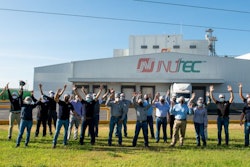
Humans have been using lactic acid for millennia to preserve their own food in the form of sauerkraut, sourdough and other fermented edibles. Lactic acid also has a history in pet food. More than six decades ago, early moist pet foods used lactic acid to prevent spoilage by mold and other microbes. The chemical still serves in dog and cat foods to protect palatability and aid moisture retention. In the growing raw pet food trend, lactic acid may continue to help producers by fighting Salmonella when used along with high-pressure processing.
Lactic acid may also help kill Salmonella in raw dog foods. While raw feeding has grown in popularity, numerous recalls and United States Food and Drug Administration alerts have involved the products. Raw pet foods must meet stringent federal regulations against pathogens, while still maintaining the rawness of the products. Conventional production and sterilization methods tend to heat the foods to the point of cooking. High pressure processing provides an acceptable option for raw pet food by creating intense force uniformly around a pet food container, usually in a sealed tank of water. That pressure is transferred instantly and equally throughout the raw pet food. Under this high pressure, disease-causing microorganisms and food-spoiling enzymes are deactivated. The technique works regardless of package size and shape, as long as the container can withstand the processing conditions. The pressures used in HPP causes few physical changes to the ingredients since the pressure doesn’t seem to seriously affect covalent bonds (a type of atomic-scale attraction) in foods. However, the amount of time used to process a raw product affects energy usage, cost and the physical properties of the final product. By increasing the effectiveness of high-pressure processing, lactic acid may aid raw pet food safety.
Experiment using lactic acid in raw dog food
A group of researchers used lactic acid in raw dog foods as the products underwent high-pressure processing. The scientists experimented to evaluate the influence of lactic acid on the ability of Salmonella to survive high-pressure processing. Lactic acid concentrations ranged from 0 to 7.2 g/kg. They also evaluated the effects of pressure intensity and pressure-holding time from 0 to 7 minutes. After four minutes of high-pressure processing treatments at 500 megaPascals, the scientists estimated the probability of Salmonella contamination a non-acidulated product to be .03%. An extra four to six minutes under pressure reduced that probability by approximately 50 times. Lactic acid had an even more dramatic effect.
In raw dog foods with 3.6 g/kg of lactic acid, the increase in processing time resulted in a 475-fold reduction in the probability of Salmonella contamination. The scientists concluded that adding lactic acid to raw pet foods may prove to be a valuable step for reducing the potential for contamination and costly recalls.
The journal Animal Feed Science and Technology published the results of the experiment involving lactic acid in raw dog food undergoing high-pressure processing.

















